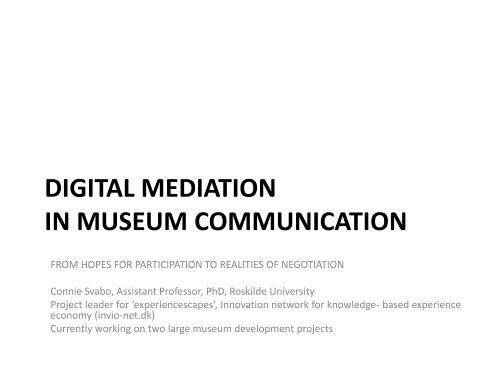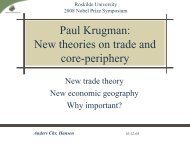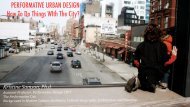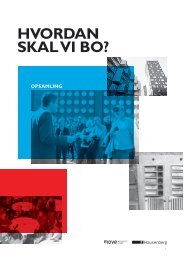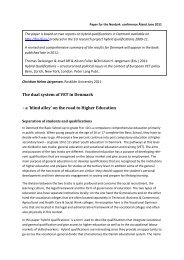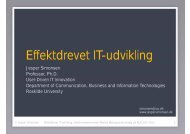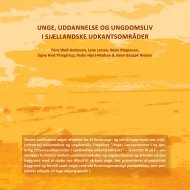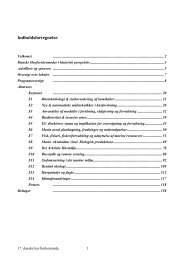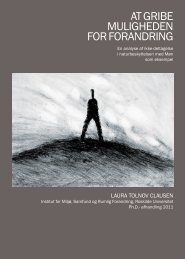Digital mediation in museum communication_ Connie Svabo
Digital mediation in museum communication_ Connie Svabo
Digital mediation in museum communication_ Connie Svabo
Create successful ePaper yourself
Turn your PDF publications into a flip-book with our unique Google optimized e-Paper software.
DIGITAL MEDIATION<br />
IN MUSEUM COMMUNICATION<br />
FROM HOPES FOR PARTICIPATION TO REALITIES OF NEGOTIATION<br />
<strong>Connie</strong> <strong>Svabo</strong>, Assistant Professor, PhD, Roskilde University<br />
Project leader for ‘experiencescapes’, Innovation network for knowledge- based experience<br />
economy (<strong>in</strong>vio-net.dk)<br />
Currently work<strong>in</strong>g on two large <strong>museum</strong> development projects
Focus of presentation<br />
• On-site visitor experiences<br />
• Mobile media, but also mention of computer-based<br />
<strong>in</strong>formation kiosks <strong>in</strong> exhibitions<br />
• <strong>Digital</strong> media and hopes for participation<br />
• <strong>Digital</strong> media <strong>in</strong> actual visitor experiences<br />
• Work<strong>in</strong>g strategically with visitor experiences,<br />
digital media and science <strong>communication</strong>
Why are digital media and participation frequently seen as <strong>in</strong>terrelated?<br />
DIGITAL MEDIA AND<br />
PARTICIPATION
• In the first celebration of mobile media (and<br />
digital media <strong>in</strong> general) there was a<br />
fundamental conviction that these held<br />
unique possibilities for new forms of<br />
<strong>in</strong>teraction <strong>in</strong> <strong>museum</strong>s.<br />
• e.g. that they could: ”mediate personally<br />
reward<strong>in</strong>g <strong>museum</strong> experiences that no other<br />
medium can replicate”<br />
(Tallon 2008)
“The growth of social Web technologies <strong>in</strong> the mid-<br />
2000s transformed participation from someth<strong>in</strong>g<br />
limited and <strong>in</strong>frequent to someth<strong>in</strong>g possible anytime,<br />
for anyone, anywhere. We entered what MIT<br />
researcher Henry Jenk<strong>in</strong>s calls a “convergence culture”<br />
<strong>in</strong> which regular people—not just artists or<br />
academics—appropriate cultural artifacts for their own<br />
derivative works and discussions. ”<br />
(Simon 2010)
<strong>Digital</strong> culture, participatory culture<br />
• Accord<strong>in</strong>g to Simon: web technologies make new<br />
forms of participation possible<br />
• <strong>Digital</strong> media are seen as a direct path to<br />
audience <strong>in</strong>volvement and user participation<br />
– a way for <strong>museum</strong>s to be ‘trendy’<br />
– to communicate with young people<br />
– reach otherwise unreachable audiences<br />
>>> Money, time and effort <strong>in</strong>vested <strong>in</strong> develop<strong>in</strong>g<br />
digitally savvy <strong>museum</strong>s
On-site digital <strong>museum</strong> <strong>mediation</strong>
• Explore the app<br />
– Kalklandet (Land of Limestone), Stevns Kl<strong>in</strong>t<br />
– Explorer, American Museum of Natural History<br />
• Discuss what role the visitor is asked to play <strong>in</strong><br />
the <strong>communication</strong> relationship
(Simon 2010)
• <strong>Digital</strong> <strong>mediation</strong> does not automatically br<strong>in</strong>g<br />
participation<br />
This was a way of th<strong>in</strong>k<strong>in</strong>g “…that made technology itself<br />
a god, ignor<strong>in</strong>g all evidence that would argue otherwise.”<br />
(Samis & Pau)<br />
• <strong>Digital</strong> culture has participatory aspects, but<br />
digital media are not necessarily participatory;<br />
they have to be designed for participation
WHAT ROLE DO DIGITAL MEDIA PLAY IN<br />
ACTUAL MUSEUM VISITOR<br />
EXPERIENCES?
WHAT ROLE DO DIGITAL MEDIA PLAY IN<br />
ACTUAL MUSEUM VISITOR<br />
EXPERIENCES?
“As recently as 2008, a survey of SFMOMA<br />
visitors shows that between 78-90% of visitors<br />
read wall texts, while a far smaller<br />
number consult computer kiosks or use audio<br />
tours <strong>in</strong> their multiple and ever-evolv<strong>in</strong>g<br />
formats.”<br />
(Samis & Pau 2009)
2012 Museums & Mobile survey<br />
The three aspects of develop<strong>in</strong>g and operat<strong>in</strong>g a mobile<br />
experience that were identified as most challeng<strong>in</strong>g by<br />
those <strong>in</strong>stitutions that currently offered a mobile<br />
experience were:<br />
1) Keep<strong>in</strong>g the experience up-to-date<br />
2) Encourag<strong>in</strong>g take-up of the mobile experience.<br />
3) Production of the content (2012)<br />
http://www.<strong>museum</strong>s-mobile.org/survey/ (2.500 <strong>museum</strong>s)
http://www.slideshare.net/fullscreen/LoicT/<strong>museum</strong>s-mobile-<strong>in</strong>-2012-survey-results/42
2013 survey<br />
• In 2013 the most challeng<strong>in</strong>g is reported to be<br />
”encourag<strong>in</strong>g take-up of the mobile<br />
experience”<br />
(Tallon, oral <strong>communication</strong>, 2013 survey yet to be published)
• Visitors are not keen to use mobile media
Ph.d.-study: <strong>museum</strong> visitor<br />
experiences at Naturama<br />
• How portable objects (media/technologies/stuff)<br />
participate <strong>in</strong> <strong>museum</strong> visits<br />
– exercise pamphlets, mobile phone cameras, dress-up costumes<br />
– <strong>in</strong>spired by actor-network theory (tradition <strong>in</strong> science and<br />
technology studies)<br />
• Ethnographic fieldwork (14 months), qualitative data<br />
• Interviews<br />
– 26 on-site visitor <strong>in</strong>terviews + staff <strong>in</strong>terviews<br />
• Observation<br />
– 39 days, 21 days <strong>in</strong> exhibition, the rest <strong>in</strong> offices<br />
– written notes, audio record<strong>in</strong>gs, video record<strong>in</strong>gs
Video camera glasses<br />
camera
• 10 year old girl Bea and her family<br />
• Bea carries exercise pamphlet<br />
• Pamphlet asks family to f<strong>in</strong>d Easter eggs and<br />
to put an x by animals which have stolen eggs<br />
• While solv<strong>in</strong>g the exercise the girl comes<br />
across a digital medium: a stationary<br />
computer-based <strong>in</strong>formation kiosk
• What is go<strong>in</strong>g on <strong>in</strong> this <strong>in</strong>teraction?
Negotiation of attention<br />
• All sorts of entities negotiate about the<br />
visitor’s attention<br />
– polar bear, family member, pamphlet, easter egg,<br />
<strong>in</strong>formation kiosk, tusk of a narwhal, baby seal…<br />
• Negotiation of attention is a premise for<br />
<strong>communication</strong> <strong>in</strong> a <strong>museum</strong>/science center<br />
context
IMPLICATIONS<br />
FOR WORKING STRATEGICALLY<br />
WITH VISITOR EXPERIENCES, DIGITAL MEDIA –AND SCIENCE<br />
COMMUNICATION
• <strong>Digital</strong> media need to be considered with<br />
po<strong>in</strong>t of departure <strong>in</strong> visitor practices – what<br />
do visitors do?
• “This does not mean that we [have] abandoned hope<br />
for the special power educational technologies can<br />
br<strong>in</strong>g to bear on the <strong>museum</strong> experience. It does<br />
mean, however, that we have taken seriously our talk<br />
of meet<strong>in</strong>g our visitors where they are – a process that<br />
[…] <strong>in</strong>cludes honor<strong>in</strong>g, rather than discount<strong>in</strong>g, the<br />
magnetic pull of time-honored <strong>museum</strong>-visit<strong>in</strong>g habits<br />
– even if it means a net decrease <strong>in</strong> the presence of<br />
<strong>in</strong>teractive educational technologies on the gallery<br />
floor.”<br />
(Samis & Pau 2009)
• “List one to three ma<strong>in</strong> ideas you want visitors<br />
to take away from view<strong>in</strong>g the exhibition.<br />
What objects or didactic components of the<br />
exhibition will help them learn this?”<br />
(Samis & Pau 2009)
Strategically def<strong>in</strong>ed goals of visitor<br />
experience<br />
– which may be supported by digital media<br />
– and which may <strong>in</strong>clude the experience of<br />
participation
For discussion<br />
• Is participation important <strong>in</strong> science<br />
<strong>communication</strong> <strong>in</strong> a science <strong>museum</strong> or<br />
science center context?
• <strong>Connie</strong> <strong>Svabo</strong><br />
• Roskilde University<br />
• PhD thesis: PDF accessible on university profile<br />
• Look under 2010<br />
• Also shorter article <strong>in</strong> Unge Pædagoger (Børns<br />
Medierede Museumsbesøg<br />
• csvabo@ruc.dk<br />
• And on L<strong>in</strong>kedIn
Designs for participation<br />
• Ideas from Stevns Kl<strong>in</strong>t<br />
– Th<strong>in</strong>k of visitors as participants <strong>in</strong>stead of listeners<br />
– Facilitate social <strong>in</strong>teractions<br />
– Use services which visitors already are us<strong>in</strong>g (and<br />
thus are comfortably acqua<strong>in</strong>ted with)
• Accord<strong>in</strong>g to Simon: web technologies make<br />
new forms of participation possible, and this<br />
affects cultural activity <strong>in</strong> general: it is more<br />
participatory<br />
• Other genealogies > same result: participation<br />
– New Museology (Vergo 1989)<br />
– Cultural Postmodernism (Lash, 1990; Lash &Urry<br />
1994; Urry & Larsen 2011)


